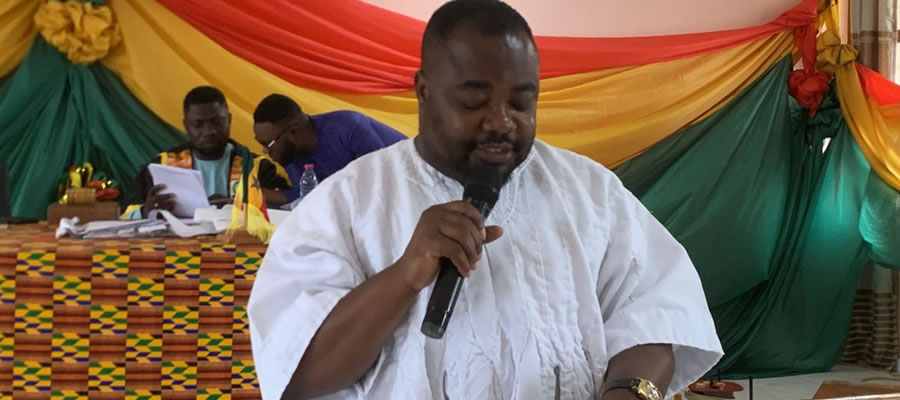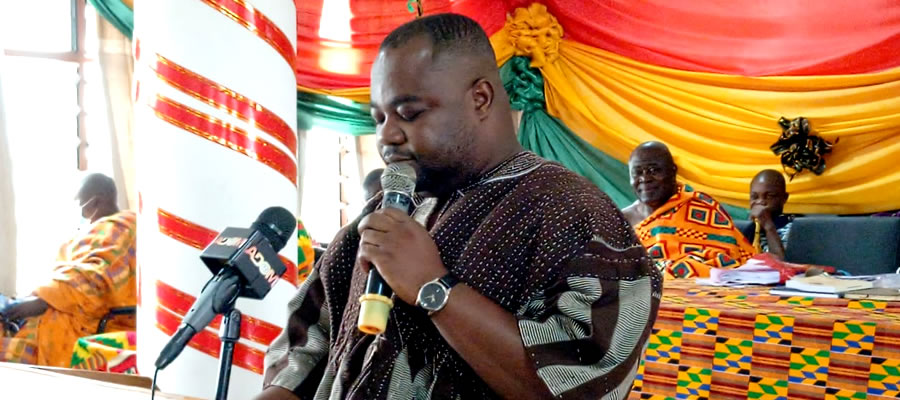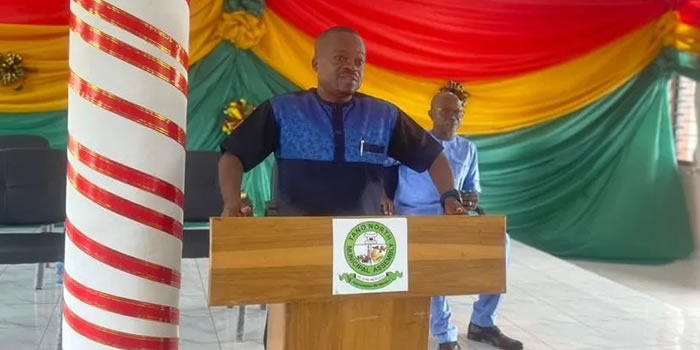

DEVELOPMENT PROJECTIONS, ADOPTED GOALS,
SUB-GOALS, OBJECTIVES AND STRATEGIES
Introduction
Human society is inevitably subject to change. However, through development planning the manner and pattern of change can be controlled to ensure the kind of change that we desire. This chapter focuses on definition of development focus, goal and objectives of the Municipal Development dimensions of the National Medium-Term Development Policy Framework (2018-2021), to enhance the realization of the desired future we envisage. This has been formulated in line with the NMTDP Framework pillars to ensure that efforts are harmonized at the Municipal, Regional and National levels.
Municipal Development Focus
The Municipal development goal for 2018-2021 under the Five Pillars of the National Development Policy Framework is
a. Promote local economic development, empowering the small and medium scale enterprises to expand and create
new businesses, encourage private sector to participate in employment generation.
b. Increase agricultural productivity, promote agricultural as a viable business among the youth, promote livestock and
poultry development for food security and income generation, protect existing forest reserves, enhance climate change resilience
c. Increase equitable access to and participation in quality education, improved equitable access to health care delivery,
access to sustainable potable water, facilitate the provision of sanitation facilities and promote health education program.
d. Extension of electricity to newly developed areas, rehabilitate feeder roads to create all year accessibility to promote
marketing of farm produce, promote a sustainable, spatially integrated, balanced and orderly development of human settlement
e. Build the capacity of the Assembly and its sub-structures, improve popular participation at the Municipal, enhanced
revenue mobilization
Projected Development Requirements for 2018-2021
Projections are important as it serves as one sure way of making sound judgments about the future. Government, policymakers and Planners around the world use population projections to gauge future demand for food, water, energy and services, and to forecast future demographic characteristics. Population projections can alert policymakers to major trends that may affect economic development and help policymakers craft policies that can be adapted for various projection scenarios. Owing to the above relevance of population projections, it is imperative that demographic characteristics as well as basic service needs for the Tano North Municipal are projected for the plan period (2018-2021) in order to make sound judgments and efficient allocation of resources to projects and programmes.
Assumptions for Population Projection
• The current migration trend will remain constant throughout the planned period
• The proportion males to females will remain constant throughout the planed period
• The proportionate share of the various age cohorts will remain the same throughout the planned period.
• Birth and death rates remain constant throughout the planned period
Justification of the Method Used
The exponential method of population projection was used to project the population of Municipal and communities. The method was used due to the advantages it offers which are related to the situations in the Municipal. The geometric method is appropriate for projections within a long period of time. This makes it very relevant to use since the plan period is between 2018 and 2021 and the year 2010 was used as the base population. The formula for this projection is defined as Pt =Po(ert) where;
Where Po = the current (base-year) population
Pt = the future population
r = the population growth rate
t = the projection period in years
e = base of the natural logarithm which is constant at 2.718282
3.3 Project Population of Tano North Municipal for 2018-2021
The population of Tano North Municipal is projected with the rate of 2.4% which is the current population growth rate of the Municipal. Table…shows the population of the Municipal for the next four years.
The Municipal is expected to have a percentage change of 5.9% by the end of the plan period. The changes in the population will be used to undertake various needs assessment of the Municipal within the plan period. As a result of the needs assessments that will be undertaken for the Municipal, the population of the Municipal was further divided into the specific age cohort to help in undertaking the needs assessment in relation a specific group in the entire population. The proportion of males and females under the various age cohorts are shown in table 3.2
Population of the Communities in Tano North Municipal
The population of the Municipal was further brought to the community level using some selected communities. This was to help determine the needs assessment at the community levels. The populations of the various communities are shown in table 3.3
Table 3.3 shows that within the plan period Duayaw Nkwanta will have the highest population (21,244) whiles Ahyiayem also will record the least population (966) in 2021. The new populations of the various communities will increase the demand for various facilities and services. Consequently, this will also put pressure on the existing facilities and services if there are no interventions.
Educational Projections
Quality education is one of the key ingredients of social development in Ghana particular and the Municipal as a whole. To help achieve this, there is the need to put some measures in place so that children of school going age would have more access to education. Adequate provision of classrooms, tables and chairs, teachers, other teaching and learning materials are all the necessary social services that would cushion the idea of quality education in the Municipal.
However, the Municipal lags behind in terms of the aforementioned amenities because the number of children of school going-age far outstrips the supply of these social services. Accordingly, measures to improve education in the Municipal can be solved or tackled holistically by looking critically at population growth and distribution, the resources at the disposal and how the people can have access to these facilities.
To help achieve these, the Assembly is expected to put up more school blocks, construct teachers quarters and supply tables and chairs to meet the enrolment demand. Table 3.4 and 3.5 show how school enrolment will increase from 2018-2021.
Assumptions
• A preschool will have only 2 classrooms and shall contain a maximum number of 40 pupils
• A primary school will contain 6 classrooms and shall contain a maximum of 45 pupils
• A JHS shall contain three classrooms and maximum of 40 pupils
• Schools would be provided
Note: Any classroom provided for the purpose of providing education is considered a classroom and therefore counted irrespective of the nature except sheds, open air, and churches. This consideration gives a misleading impression that, there are enough classrooms but in real sense, many of them are dilapidated, uncompleted, and makeshift structures.
Water Projection
Health Projection
In order to ensure good and effective health care delivery in Tano North Municipal for the plan period (2018-2021), health infrastructure needs to be improved to sustain the lives of the people which necessitate the need of for assessment on the health infrastructural gaps of the Municipal.
The following assumptions were used to undertake the health needs assessment
• The existing health facilities will not change within the plan period
• The standard for undertaking the needs assessment will not change within the plan period.
• The projected population should remain the same for the plan period
The table 3.6 shows the various health infrastructures available in the Municipal and the number required to meet the health needs of the people for the plan period.
It can be realised from the table above that development interventions to cater for the health needs of the Tano North Municipal by the end of the plan period will require 2 health centres, a Poly Clinic and 17 CHPS compound
Revenue Projections
Spatial Development Option
For each refined development priority of the Tano North Municipal has more or less a spatial implication in a long term planning horizon. Various stakeholders were engaged to select a long term spatial dimension which will not only fit in to the national policy framework but also enhance the future growth and development of the Municipal.
The stakeholders envisioned the Municipal in five dimensions namely;
1. Administrative zone
• To maintain Duayaw Nkwanta as an administrative led community.
• Already existing administrative institutions
2. Agricultural and Commercial zone
• Make Yamfo Bomaa and Terchire as an agric and commercial hub of the Municipal
• Notable for the production of large quantities of tomatoes, vegetables, yam, cocoyam, cassava, plantain, pineapple etc
• Proximity to major commercial centers which includes Sunyani, Techiman, Akomadan, Tepa and Kumasi
• Surrounded by farming communities
• Existence of water bodies which can be exploited for irrigation purposes eg. Tanokrom
3. Industrial Zone
• Earmarked Tanoso and Afrispakrom as an Industrial Zone
• Existence of large deposit of clay at Tanoso which can be exploited to produce ceramics
• Vast land has been earmarked for light industrial area at Afrisipa and Duayaw Nkwanta
4. Forest Reserve
• Maintain the existing 2 forest reserves at Bomaa and Yamfo
5. Enhance the capacity of the already existing industries(agro processing industries)
• Already existing agro processing industries
• Proximity to rural farming communities for raw materials
Mining Zone
• Newmont has acquired concession for mining in 5 communities namely Yamfo, Susuanso, Afrsipakrom,Terchire and Adrobaa
The Municipal development option is presented in the figure below
Municipal Level Monitoring and Evaluation
At the Municipal level, the activities of Monitoring and Evaluation are responsibilities of the Municipal Planning Coordinating Unit (DPCU). Section 46, sub-section 3 of the Local Government Act, 1993, Act 462 as amended Local Governance Act, 2016 Act 936 establishes the DPCU to assist the Municipal Assembly to execute designated planning functions.
The National Development Planning (Systems) Act, 1994, Act 480 defines the DPCU’s planning, M&E and coordinating functions. The DPCU is responsible specifically for the preparation of monitoring and evaluation procedures as well as the monitoring and evaluation plan, using NDPC guidelines.
Again, it is required to provide over all Municipal level monitoring and evaluation of projects and development policies. Actual specific project monitoring and evaluation are, however, the responsibility of the Municipal sectoral departments.
Assistance would be obtained from the community, governmental and non-governmental organizations. To fulfill its M&E functions, the DPCU of the Tano North Municipal Assembly shall perform the following roles and responsibilities.
• Be directly responsible for the development and implementation of the Municipal M&E plan
• Convene quarterly DMTDP performance review meetings with all stakeholders
• Liaise with RPCU to agree on goals and targets
• Define indicators for measuring change, especially on gender equity and other cross cutting issues
• Collect and collate feedback from the sub-Municipal levels for preparation of the Municipal Annual Progress Report
• Conduct Mid-Term, Annual and Terminal Evaluations of the DMTDP and
• Produce composite Municipal Quarterly and Annual Progress Reports using the NDPC proposed Municipal M&E Report
The outline for the Quarterly and Annual Progress Report is shown below:
Quarterly and Annual Progress Reports Format
Title Page
i. Name of the MMDA
ii. Time period for the M&E report
Introduction
i. Summary of achievements and challenges with the implementation of the DMTDP
ii. Purpose of the M&E for the stated period
iii. Processes involved and difficulties encountered
M&E Activities Report
i. Programme/Project status for the quarter or year
ii. Update on funding sources and disbursements
iii. Update on indicators and targets
iv. Update on critical development and poverty issues
v. Evaluations conducted; their findings and recommendations
vi. Participatory M&E undertaken and their results
The Way Forward
i. Key issues addressed and those yet to be addressed
ii. Recommendations
Programme/Project Monitoring and Reporting
Project Monitoring formally begins as soon as actual implementation of a project starts, and it is at ensuring its progress according to schedule, standard quality of work, and the correct delivery of inputs (including labour) according to time, quality and quantity.
In accordance with the planning guidelines issued by the NDPC, the Tano North Municipal Assembly being the Planning Authority as conferred on it by the Local Government Act (Act 462) prepared its MTDP in accordance with the National Goals. After the successful preparation of the DMTDP, annual action plans outlining various projects were derived. To keep an accurate data on the projects implemented the Municipal prepared a programme and project register to provide a detailed information on the programme and project status.
Dissemination
The Monitoring and Evaluation reports will be forwarded to all stakeholders who have participated in the preparation and Implementation of the plan as well as the monitoring and evaluation process. Copies of the annual progress reports will be sent to RPCU, NDPC, and other stakeholders.
The purpose for disseminating reports is to promote accountability and transparency in the Municipal.
Public hearings will also be organized in each of the five Town and Area Councils to brief community members on the progress made as far as the implementation of the plan is concerned and the achievements made so far. The strategies to be adopted for disseminating the M & E findings will include community fora, meeting with community leaders, as well as radio broadcast.
Evaluation
One important component of the planning process is evaluation. The essence of this step in the cycle is to assess the performance of the project or plan implementation and why some targets have not been met. Undertaking evaluation helps to identify progress and also track problems associated with the various projects being carried out.
Through the evaluation the reasons for successes and failures will be identified. These will then become lessons which will be fed into subsequent projects so that similar problems might not recur in future. It is in this direction that evaluation will be an integral component of the M & E plan. The Municipal Planning and Coordinating Unit in collaboration with other Civil Society Organisations such as CBOs, NGOs and the Development Partners as well as beneficiary communities will embark on evaluation to assess the performance of the Municipal Medium Term Development and its Component Projects.
In doing this, a mid-term evaluation will be done to help improve the performance of the projects during the rest of the implementation period. Besides, an end of project evaluation will be undertaken to assess the performance of the DMTDP and to identify successor projects as well as projects that have not been implemented successfully. In addition, ex-post evaluation will be conducted a few years after the DMTDP implementation to assess its lasting impact.
Other studies and evaluations such as thematic evaluation, Municipal poverty profiling and mapping, impact assessment (economic, social, and environmental), strategic evaluation and beneficiary assessment will be conducted by the DPCU and its collaborators.
Participatory Monitoring and Evaluation
For any intended beneficiaries of any development intervention to be convinced that the project objectives have been met, they must be involved in the monitoring and evaluation. Their role is to assist in the selection of indicators for monitoring and evaluation. This is intended to build a good partnership between the Municipal assembly and other stakeholders. It is on this premise that the assembly will employ a participatory approach in its monitoring and evaluation to ensure that all stakeholders are involved in the process.
Participatory Monitoring and Evaluation will be used to encourage greater participation of communities, Civil Society Organisations as well as our Development Partners in the Monitoring and Evaluation process. Special attention will be paid to the vulnerable and excluded and the poor in society. The adoption of Participatory Monitoring and Evaluation is to encourage the communities, CBOs/NGOs to identify their own needs and objectives and then monitor and evaluate to assess whether interventions have met their expectations (needs and objectives).
To promote and sustain PM&E, there will be the need to build capacity of stakeholders especially CSOs and Zonal Councils on PM&E methods like Participatory Rural Appraisal (PRA), Citizen Report Card and Community Score Card to enable them monitor projects and programmes implemented within their areas.
Date Created : 11/26/2018 7:55:08 AM












 facebook
facebook
 twitter
twitter
 Youtube
Youtube
 +233 593 831 280
+233 593 831 280 0800 430 430
0800 430 430 GPS: GE-231-4383
GPS: GE-231-4383 info@ghanadistricts.com
info@ghanadistricts.com Box GP1044, Accra, Ghana
Box GP1044, Accra, Ghana